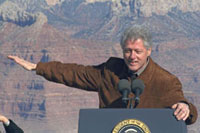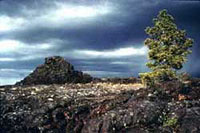
The Grand Canyon just got grander.
Photo: Council on Environmental Quality.
President Clinton has been on a national monument tear of late, setting aside eight areas encompassing more than 1 million acres since January. National monument status gives the federal government increased authority to prevent development and limit logging and other commercial and recreational activity on lands considered particularly sensitive or of great historic value.
Many Western Republicans remain less than pleased with these federal “land grabs,” through which Clinton has protected a total of 3.9 million acres over the course of his presidency. But those same Republicans went down to a ringing defeat in the House earlier this month (243 to 177) when they attempted to tack language onto the Interior Department appropriations bill barring the use of federal funds for the design and management of the monuments. There is separate legislation pending that would require local and congressional approval for national monument status. It is not expected to pass.
The rush of monument making fits into a larger administration pattern of employing whatever means available to rack up accomplishments in the waning days before a new president takes office.
The question some enviros are asking now is who is the driving force behind the current craze? Are ideas for new sites coming from inside Interior or are they still flowing from the White House itself, as they did under former Council on Environmental Quality Chair Katie McGinty?
Interior spokesperson Michael Gauldin says that while the process is still a “partnership” with CEQ, the real point man is Interior Secretary Bruce Babbitt himself (which of course is what agency flaks are trained to say).
“A lot of the sites are places where some kind of protection has been discussed and debated for some time,” Gauldin said. “And they come to the secretary’s attention in various ways, through his knowledge of the West, having conversations with citizens and members of Congress, and through local groups contacting him. The secretary is really kind of bird-dogging it himself and serving as the cavalry scout bringing reports back to the White House.”
Once those reports come in, they land in the lap of Interior lawyers, including Molly McUsic, who help determine the legal feasibility of applying monument status to a given parcel of land. The department’s preference, according to Gauldin, is to have the land protected by Congress. When that fails, as it often does with Republicans in charge, Clinton breaks out the executive-order pen.
There have been rumors floating around in Washington and Alaska recently that the Arctic National Wildlife Refuge might make it into the next round of monument designations, along with other lands in Alaska. But Gauldin says ANWR is “not on the table.”
“That’s just some kind of rumor started by the oil industry to try and get drilling started before it becomes off-limits,” he said.

Craters of the Moon National Monument.
Photo: National Park Service.
Lands likely to make the list next time around include the historic Missouri Breaks in Montana and additional acreage at the Craters of the Moon National Monument in southern Idaho.
And what of the notion that Republicans aren’t putting up much of a fight over monuments now because they plan to rip any protections to shreds in the next Congress under (they hope) a Bush administration?
“The fact is that Congress — today, tomorrow, or anytime — could unmake any of the national monuments that have been made,” Gauldin said. “But so far, it’s never happened.”
The Dirty Work
The Environmental Working Group unveiled a new website last week intended to follow the political giving of 454 industry political action committees (PACs). The Dirty Money Tracker is a database searchable by candidate or PAC name and broken down into several categories of PAC groups: Dirty Air, Dirty Water, Global Warming, Public Land Use, and Toxics.
In an interview last week, EWG President Ken Cook described the site as a “resource to help people answer follow-up questions regarding the relationship between money and environmental policy.”
Purity Test Results
Our last column featured a quote from an unnamed “green wag” on Ralph Nader‘s presidential bid: “I’m looking at Nader and thinking, right, like he could get anything done. Being a purist doesn’t get you anywhere.”
Responses flooded in at a record rate, and Nader defenders were particularly vocal:
Tim McKee: “Nader was working on environmental issues while Gore was in college smoking pot. I’ll take a proven ‘purist’ over a corporate sell-out any day!”
Harold W. Beu: “I think there is some truth to the idea that a purist can get nothing done. But a purist can really shake up things. Just think about Ross Perot. If there was ever an unqualified presidential candidate, it was Perot. And yet, his purity on the deficit issue hit a chord, such that both Bush and Clinton had to respond to it.”
“LCotler”: “Nader’s not a ‘purist,’ but he is the wisest, most honest candidate we’ve had since Lincoln. A purist? To a cynic, someone wise and honest might seem like a ‘purist.'”
Kate Curan: “I offer two comments to the quoted wag: (1) Knowing which end of a critter does the wagging, you appear to be appropriately named, and (2) Tell it to Mother Teresa.”
David Shelton: “Seems to me Nader has gotten a lot of stuff done by being a purist pain-in-the-ass. I think Gore should try to get him as a running mate and if elected he could let Nader run around the country giving the polluters hell.”
[Editor’s note: There’s plenty more where this came from. Check out other reader comments on Nader’s candidacy in our letters section.]
Back to the Races
This week we turn to the poltical contests shaping up in the Great Plains states.

North Dakota: All eyes are on the governor’s mansion this year, as incumbent Republican Edward T. Schafer is retiring, setting up an open-seat battle between state Attorney General Heidi Heitkamp, a Democrat, and Republican John Hoeven, who recently resigned as president of the Bank of North Dakota. Most analysts rate this race a toss-up with neither candidate starting with the clear advantage.
As with other states in the Midwest and the Plains, gas prices now rest atop the issue agenda. Heitkamp recently announced she would establish a task force to determine why prices are so high in North Dakota, much as Vice President Al Gore has done at the national level.

South Dakota: Snooze city. A lock for Bush at the presidential level, and Rep. John Thune (R) should breeze to reelection in the only other federal race on the ballot this fall.
Nebraska: Attention is focusing on the open Senate race in the Corn Husker State following Democrat Bob Kerrey’s decision to bail out in favor of a post as president of New School University in New York City.

The race pits two failed Senate candidates, former Democratic Gov. Ben Nelson (who lost the 1996 Senate race to Chuck Hagel) and Republican state Attorney General Don Stenberg (who lost the GOP primary to Hagel in ’96).
Most analysts give a slight edge to Nelson based on his widespread popularity as governor. As for Nelson’s embarrassing ’96 defeat, Democratic insiders argue that he learned his lesson and will wage a far more energetic campaign this time around.
No partisan change is expected in the state’s House delegation, with former University of Nebraska football coach Tom Osborne heavily favored to replace retiring GOP Rep. Bill Barrett.

Kansas: No Senate or governor’s race in the Jayhawk State this year, and the only vulnerable House member is Democrat Dennis Moore, a freshman who knocked off Republican Vince Snowbarger in 1998.
Republicans have a late, contested primary (Aug. 1) and face an uphill battle against the moderate Moore, who won last time around based on strength in traditionally Democratic Kansas City coupled with solid support in traditionally Republican Johnson County.
Moore has already gotten help from the Sierra Club in the form of television ads and on-the-ground field support and is likely to get more, along with heavy backing from the national Democratic Party.

